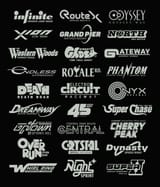>>459922Step 3: Adding Stylistic Elements
Once the text is set, you’d enhance the logos with additional design elements to reflect the theme:
Shapes and Icons: Many of these logos include symbols like arrows ("North Hill Battle"), circles ("Nyx Raceway"), or even a ghost ("Street Ghost Time Trial"). These are often drawn in Illustrator using tools like the Pen Tool, Ellipse Tool, or Pathfinder to create custom shapes.
Effects: Adding effects like gradients, shadows, or outlines can give the logos depth. For example, "Over Run" has a slight 3D effect, which might be achieved using Illustrator’s 3D tools or by manually adding highlights and shadows.
Layout: Some logos have secondary text (like "Quarter Mile" in "Phantom Tunnel" or "Special Route X" in "Route X"). You’d experiment with hierarchy, placing the main name prominently and the secondary text in a smaller, complementary font or style.
Step 4: Color and Consistency
In your image, the logos are all in a monochromatic gray scheme, which gives them a cohesive look. This is likely a deliberate choice to make the collection feel unified, even though the styles vary. In Illustrator, you’d:
Set up a color palette (in this case, shades of gray).
Apply the colors to each logo, ensuring consistency in stroke weight and shading.
If these were for a real project, you might create alternate color versions (e.g., vibrant reds and blues for a more dynamic racing feel).
